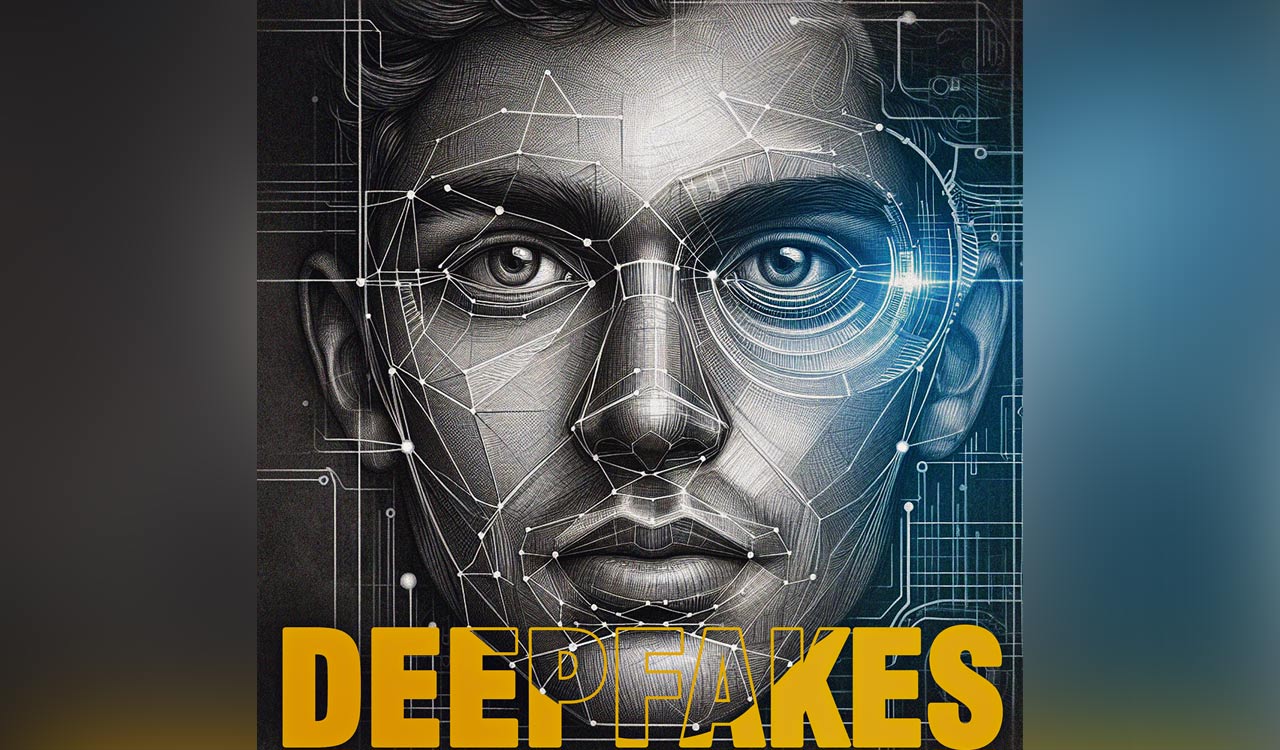Deepfakes can be used to disrupt voting patterns, change people’s perceptions and instil them with biases, thereby endangering democracy.
Published Date – 11:59 PM, Sat – 2 December 23

By Adarsh Kuniyillam
The 39th President of the United States of America, Jimmy Carter, once said, ‘The experience of democracy is like the experience of life itself — always changing, infinite in its variety, sometimes turbulent and all the more valuable in having been tested in adversity’. Democracy is a joyful experience where there is freedom guaranteed by constitutional rights.
Much before the word got popularised across the globe, India had ‘Sabhas’ and ‘Samithis’. South India was largely ruled by kingdoms of Satavahanas, Kakatiyas, Chola-Chera-Pandyas, Pallavas and others, who were largely democratic. People had the right to an audience of the king and to express their grievances. The king ruled according to the will of the people. Although nation-states emerged after the Westphalian treaty, India had a large number of independent polities in existence much before this and so can be called the cradle of democracy.
Election Commission of India
India today is a Union of States and these States form the centre of our political setup. Although unitary, each State has its own government and the people of the State have the right to elect their representatives through elections. We are unified under one citizenship but the linguistic re-organisation makes States the most important component of our political setup.
The Election Commission of India constituted under Article 324 of the Constitution is vested with the power of superintendence, direction and control of elections to Parliament, State legislatures, Office of President of India and Vice President of India. While debating the centralised nature of the Election Commission of India, Dr Ambedkar observed that provinces contain a mixture of population, the original inhabitants as well as the people who reside there. Hence, it was important that we have a single Election Commission at the central level.
RK Sidhva, who represented the Central Province and Berar, had said that instead of borrowing staff from the provinces for the elections, it was important that permanent staff be recruited for the conduct of elections across the country. This was highly important to maintain the independence of the commission. Many of the members supported the idea but since we were a newborn democracy, it was far impractical to implement this move. This led to the present-day practice where election officials are being deputed for a brief period during elections from the State and central machinery.
This is also the age of technology, rather new-age technology. The just concluded elections in five States saw a significant use of artificial intelligence. AI was everywhere. On the day of the Assembly elections in Telangana, a large number of deepfakes emerged to influence voters’ behaviour on various social media platforms. These were being endorsed and shared on a large scale. In a fraction of a second, it spread like wildfire trying to impact the minds of many voters. Madhya Pradesh was no different.
Generative AI and deepfakes can be used to disrupt the voting patterns of voters, change people’s perceptions and even instil them with biases to influence the outcome of the elections. Since elections are sacrosanct for any democracy, these technologies when misused can lead to huge political and economic risks for any country. Deepfakes can significantly alter the polls through a coercive use of force using cyberspace to oust democratic principles and practices, threatening the electoral process and its results.
Demystifying Deepfakes
According to the European Union, deepfakes are defined as manipulated or synthetic audio or visual media that seem authentic, and which feature people that appear to say or do something that they have never said or done, produced using AI techniques, including machine learning and deep learning. It can be understood as AI-generated synthetic media.
Terming deepfakes “new threat to democracy”, Union Information Technology Minister Ashwini Vaishnaw said the government will come up with a “clear, actionable plan” to tackle deepfakes and misinformation
The plan will have four key pillars: detection of deepfakes, their prevention by removing or reducing their virality, strengthening reporting mechanisms, and spreading awareness about the technology
However, when used in the right way, this technology can be beneficial. It has large negative impacts on society. Deepfakes can have malicious, deceitful and destructive potential at an individual or organisational level. A large number of psychological, financial and societal risks will arise as a result of misuse of this technology.
“AI techniques allow for automated manipulations which previously required a substantial amount of manual work, and, in extreme cases, can even create fake multimedia data from scratch,” says the report titled ETSI GR SAI 011, released by the Securing AI group of the European Telecommunications Standards Institute, adding “Deepfakes pose a complex problem, for which there is no panacea but which can best be combated by a combination of measures on various levels.”
Regulating Deepfakes
Many countries have taken initiatives to regulate deepfakes. The Cyberspace Administration of China Act provides for regulation of deepfake technologies. The Canadian government has invested heavily in the detection of deepfake technologies and the Canadian election law is against deepfakes. It bans the distribution of nonconsensual disclosure of intimate images. The European Union is working on strong laws while the United Kingdom recently passed the Online Safety Act that regulates AI.
Deceptive AI-generated content began to spread after Russia invaded Ukraine in 2022. An altered video appeared to show Ukrainian President Volodymyr Zelenskyy ordering Ukrainians to surrender
Even though the United States is yet to pass a federal law with respect to the regulation of deepfakes, many states of the US have already passed legislation in this regard. South Korea passed a law in 2020 that makes it illegal to distribute deepfakes that could harm public interests with offenders facing a huge penalty and arrest. In November this year, many countries of the world adopted the Bletchley Declaration. This declaration emphasises the shared responsibilities of governments, the private sector and the global community to ensure that AI is served for good.
Pouring Investments
Deepfakes are created based on the Generative Adversarial Network (GAN) approach. Using deep learning methods, GANs can generate or create data on their own using a certain set of inputs. As a result, synthetic media can be created by voice cloning or video manipulation. Today, generative AI tools such as ChatGPT and Midjourney are gaining massive popularity. It is estimated that by 2025, 30% of outbound messages from large organisations will be synthetically generated, from less than 2% currently.
Each new conflict, or election season, provides new opportunities for disinformation peddlers to demonstrate the latest AI advances
It is expected that investments in the AI sector will reach a massive $422.37 billion by 2026 at a compound annual growth rate of 39.4%. According to Goldman Sachs, generative AI could raise global GDP by 7% and increase productivity by 1.5% in the next decade. PwC estimates this could contribute $15.7 trillion to global GDP by 2030. Hence, companies must create an ecosystem for deepfake detection at their end. Techniques such as watermarking of products, increased usage of blockchain technology through the usage of non-fungible tokens, algorithm auditing, and the use of machine learning techniques to identify and detect deepfakes on their platforms are crucial. Companies have to invest in manpower training in these areas.
The World Economic Forum predicts that by 2027, there will be a 40% increase in the number of AI and machine learning specialists. In other words, 1 million jobs are expected to be created with the increase in usage of AI and machine learning. Additionally, roles such as data analysts, data scientists, big data specialists and information security analysts too are expected to see an increase of 30-35% and 31%, respectively. Over 2.6 million jobs are expected to be generated in the areas of AI and machine learning.
The public must be educated on the manipulative usage of these new technologies on a priority basis. The industry must collaborate on creating an ethical protocol on the prevention of the spread of fake through cyberspace, A quick alert protocol mechanism that immediately detects deepfakes, prevents its spread and immediately informs the enforcement agencies is the immediate need of the hour.
Changes in Law
Although social media websites are also electronic media and model code of conduct and pre-certification apply to them as well, including social media platform contents, there are no regulations on the usage of generative AI and deepfakes.
There is a need to amend our electoral laws so that the Election Commission has a permanent set of staff and its own recruitment process. A separate budget has to be provided for the commission to be the watchdog of our democracy. This will help the commission investigate and take immediate action on complaints being referred to it. In addition, the Centre has to bring in a law to regulate Generative AI and deepfake technologies.
AI experts and political scientists warn of the risks next year when several countries hold major elections, including the US, India, Pakistan, Ukraine, Taiwan, Indonesia and Mexico
Election rules have to be amended and usage of disruptive AI and deepfakes should be categorised as a criminal offence. The Information Technology Act must introduce specific provisions against the usage of deepfakes. Any usage of deepfakes or generative technologies for disrupting the mental and social health of individuals, or businesses or any attempt to use these technologies to coerce people’s behaviour against them should be viewed as criminal acts. Moreover, generative AI and deepfakes must be banned during elections. Social media sites must appoint their own nodal officer to regularly check the spread of such content on their platforms.
This apart, civil society needs to act in unison to identify and stop the spreading of this deepest threat to our polity today. If unleashed with malafide intentions, this technology will bring our governments down and will be a grave threat to our electoral democracy but if ethically nurtured it can be our guiding star for the next decade.
It is expected that investments in the AI sector will reach a massive $422.37 billion by 2026, this technology could contribute $15.7 trillion to global GDP by 2030
Dr BR Ambedkar once said, “Political democracy cannot last unless there lies at the base of it social democracy. What does social democracy mean? It means a way of life which recognizes liberty, equality and fraternity as the principles of life”. Only when liberty, equality and fraternity co-exist can we dream of social democracy and political democracy. The government has to take steps to regulate such technologies that will disrupt our liberty, equality and fraternity eventually destroying our democracy. These regulations should at the same time be able to nurture innovations in this sector.
It is expected that the Digital Services Act soon-to-be-tabled in Parliament will have stringent norms regarding regulation and the spread of deepfakes. The responsibility of regulation lies equally with governments, organisations and each one of us. Only then we will have a vibrant and pluralistic people’s democracy.





